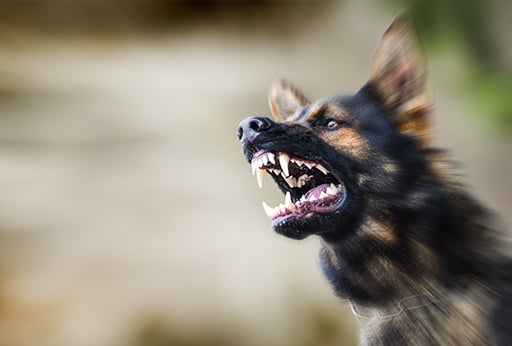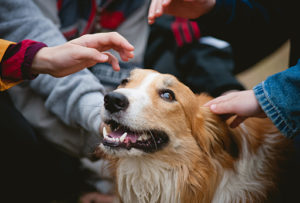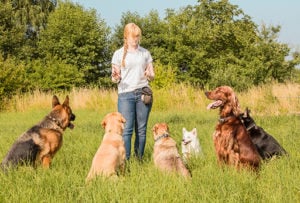
Dog bites can cause serious injuries, whether from a large breed dog like a Rottweiler or pit bull, or a small dog, such as a Jack Russell terrier or Chihuahua. Puncture wounds from dog bites can be painful and carry the risk of infection, meaning that every dog bite should be taken seriously.
Just as important as treating dog bite injuries, however, is preventing them from happening in the first place. If your dog exhibits aggressive behavior to people or other dogs, it is your responsibility as the dog owner to address the behavior to prevent attacks.
Canine aggression can be scary, stressful, and embarrassing, particularly when it’s coming from your own dog. Do not give up hope– there are ways to treat aggression. Below are tips for dealing with and preventing aggressive dog behavior.
See a Vet
Some health problems, such as rabies, thyroid issues, and metabolic disorders, can cause an otherwise friendly dog to begin exhibiting aggressive behaviors. Hidden injuries may also cause your dog to behave abnormally. Speak with your veterinarian to see if your dog’s behavior problems may be related to a health condition.
Additionally, always make sure your pup is up-to-date on vaccines and regular preventative healthcare. This will keep your dog healthy and help prevent others from getting sick in the event of a bite.
Understand Your Dog’s Stressors
Dog aggression is nearly always caused by some kind of underlying fear, stress, or pain. By recognizing the situations that cause your dog to become aggressive, you can begin to understand the motivation behind their aggression. Types of aggression include:
- Protective aggression
- Territorial aggression
- Fear aggression
- Social aggression
- Leash aggression
- Possessive aggression
- Defensive aggression
- Sex-related aggression
- Redirected aggression
Recognize Signs of Dog Aggression
In many cases, dogs display warning signs before resorting to biting. Understanding how your dog displays fear or stress can help you prevent attacks. By keeping an eye on your dog’s body language in potentially stressful situations, you may be able to anticipate and therefore prevent a bite. Common signs of aggression in dogs include:
- Growling
- Snarling
- Snapping
- Lunging
- Becoming still and rigid
- Avoiding eye contact
- Yawning or licking lips
Train and Socialize Your Dog Appropriately
It is crucial for dogs to receive proper training and socialization from puppyhood in order to help them learn how to interact appropriately with humans and other dogs. In many cases, aggressive or fearful dogs were not given proper socialization when they were young, and therefore new situations or people may cause them unnecessary stress.
Dog training and socialization involves exposing your dog to other dogs, humans, and new experiences. While it is easier to socialize a puppy, thanks to their curiosity and lack of world experience, it is possible to socialize an adult dog as well.

When exposing your dog to an unfamiliar situation, start slow. Begin in controlled environments, where things won’t get out of hand and traumatize your dog. Short walks around the neighborhood, where your dog is allowed to sniff and explore without being approached by other dogs or humans, is a good place to start.
Other activities that can help your dog learn to remain calm in strange situations include:
- Call your dog’s name and reward them when they look at you. Start in a quiet, familiar environment, and gradually work up to busier areas.
- Walking side-by-side with another dog (but keep the dogs several feet apart, unable to reach each other)
- Invite an adult friend or family member over and ask them to ignore your dog until your dog is able to be calm
Use treats and praise as positive reinforcement while your dog is trying new experiences. This will help them associate the stimuli with good feelings.
If your dog has harmed other dogs or people, consider using a basket muzzle while you work on behavior modification in order to keep everyone safe.
Avoid introducing an aggressive dog to small children except in very controlled environments, where everyone is able to remain calm and you can ensure that no one will be hurt. A dog trainer or veterinary behaviorist can help you determine if, when, and how you should introduce your dog to young children.
Spay or Neuter Your Dog
When it comes to sex-based aggression, you may be able to fix or improve your dog’s behavior by having your dog fixed. Intact male dogs are prone to aggression toward other male dogs, particularly if a female in heat is nearby.
Female dogs may also exhibit aggressive behaviors toward other dogs of either sex, but especially males.
Warning signs of sex-related aggression include:
- Refusal to follow commands
- Barking or lunging
- Destructive behavior
- Territorial behavior, such as marking
- Urge to escape or roam
Spaying and neutering dogs can solve sex-related aggressive behavior as well as a variety of other issues, such as marking. Studies have also shown that dogs who have been spayed or neutered may live longer than unaltered dogs.
Exercise Your Dog Regularly
While walking your dog certainly won’t fix all aggressive behavior, it may provide them with the mental and physical stimulation they need to relax in stressful situations. Many dog breeds were bred to be active, working animals. A dog who spends too much time lying around, especially alone, will find ways to expel that energy, and it likely won’t be in a positive manner.
Dogs who are not getting enough exercise may exhibit:
- Destructive behavior
- Restlessness
- Depression
- Excessive barking
- Attention seeking
- Lunging or pulling while on leash
- Biting, nipping, or scratching
By giving your dog the chance to walk, run, or play with you or another dog, you expose them to stimuli that will engage their brain and wear them out, and as the old saying goes: A tired dog is a good dog.
Avoid Situations That Trigger Aggressive Behavior
If you understand the type(s) of aggression your dog displays, you may be able to help them avoid those situations. For example, if your dog exhibits possessive aggression and resource guarding behaviors, you can move their food bowl into a quiet room during meal time and allow them to eat alone.
Early in the process of behavior modification, it is wise to avoid situations that may be triggering for your dog, particularly if it may pose a danger to other people or animals. If your dog displays fear aggression when feeling cornered or trapped by other dogs, you can avoid dog parks and other places where off-leash dogs may be present. When people visit your home, put your dog in a secure room or kennel.
While canine aggression can be difficult to treat, in many cases, all hope is not lost. Seeking professional help can help you learn what causes your dog’s behavior problems and understand how to give your dog the best chance at a calm, happy life.
See a Dog Trainer or Behaviorist
While all of the above suggestions can help you begin to understand your dog and improve their behavior, aggression in dogs can be a complicated issue. Your dog may have multiple triggers, or exhibit a variety of aggressive behaviors.

A professional dog trainer or behaviorist can help you understand the causes behind the aggression, and come up with a treatment plan to address your dog’s needs. Your local humane society may have resources to help you find a behaviorist in your area.